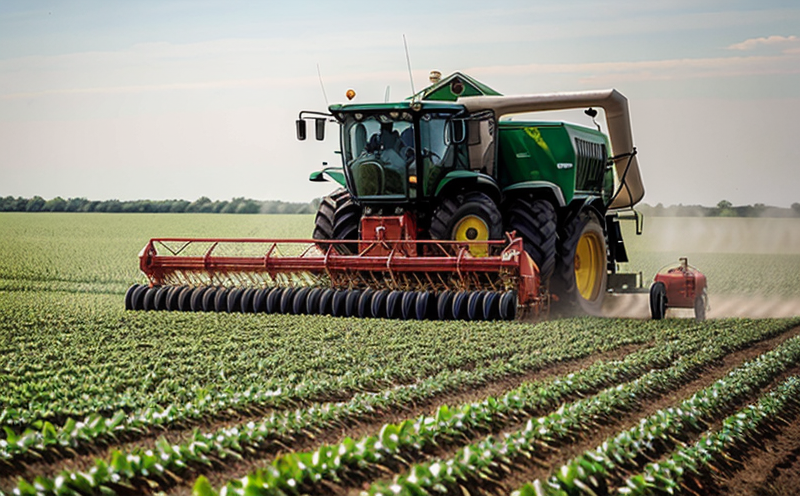Crop Growth Rate Testing
Understanding crop growth rate is crucial in agriculture and forestry testing as it directly impacts productivity, resource allocation, and overall sustainability. Crop yield and productivity are key metrics for quality managers, compliance officers, R&D engineers, and procurement teams. This service ensures that crops reach their optimal growth phases accurately and efficiently.
The process involves several steps: first, the selection of representative crop samples is critical to ensure the accuracy of the results. These samples can include seeds, seedlings, mature plants, or harvested produce, depending on the specific phase being tested. Once collected, these samples are carefully prepared according to standardized protocols to minimize any external factors that could influence growth rates.
Instrumentation plays a vital role in this testing process. High-precision sensors and imaging devices are used to monitor the growth rate over time. These tools provide real-time data on plant height, leaf area expansion, biomass accumulation, and other relevant parameters. Additionally, controlled environment chambers allow for precise manipulation of environmental variables such as temperature, humidity, light intensity, and carbon dioxide levels.
The testing process is not just about quantifying growth rates; it also involves qualitative assessments that consider various factors affecting plant development. Microscopic analysis can reveal details about root systems or cellular structures, while chemical analyses might check nutrient concentrations in the soil or plants themselves. By combining these quantitative and qualitative approaches, a comprehensive picture of crop growth rates emerges.
Reporting from such tests is extensive but highly informative. It includes detailed descriptions of observed changes over time, comparisons against industry standards, recommendations for improvements where necessary. This information can help stakeholders make informed decisions about breeding programs, fertilizer applications, irrigation schedules, and pest management strategies.
Why It Matters
Crop growth rate testing is essential for optimizing agricultural practices and enhancing productivity. Faster growing crops can lead to higher yields per hectare, reducing the need for additional land or resources. This not only increases profitability but also helps in sustainable farming by minimizing environmental impact.
Rapid advances in technology have made it possible to track crop growth more accurately than ever before. However, this increased precision comes with challenges too; interpreting complex data sets requires expertise and advanced analytical tools. Therefore, reliable testing services become indispensable for ensuring accurate results that can drive decision-making processes effectively.
Moreover, understanding how different variables affect crop growth rates allows researchers to develop better varieties of plants that are more resilient under varying conditions. This knowledge is particularly valuable when dealing with climate change impacts or seeking ways to improve food security globally.
In summary, efficient crop growth rate testing contributes significantly towards achieving sustainable agricultural practices which benefit both producers and consumers alike by providing consistent quality products while conserving natural resources.
Scope and Methodology
| Parameter | Description |
|---|---|
| Crop Samples | Representative samples of the crop being tested, including seeds, seedlings, mature plants or harvested produce. |
| Preparation | Standardized protocols followed to prepare samples for testing. |
| Instrumentation | High-precision sensors and imaging devices used to monitor growth rates over time. |
| Environmental Control | Controlled environment chambers that allow manipulation of environmental variables like temperature, humidity, light intensity, and CO2 levels. |
| Data Collection | Real-time data collection on plant height, leaf area expansion, biomass accumulation, etc. |
| Analytical Techniques | Including microscopic analysis of root systems/cellular structures, chemical analyses of nutrient concentrations in soil/plants. |
The methodology employed ensures that each step is carried out rigorously to maintain accuracy and reliability. The use of advanced technologies like LiDAR sensors for measuring plant height incrementally or multispectral imaging for capturing detailed images helps provide precise measurements throughout the growth cycle.
International Acceptance and Recognition
- Crop Growth Rate Testing adheres to international standards including ISO 13528, which defines requirements for laboratory testing and calibration of measuring instruments.
- The service complies with EN ISO/IEC 17025:2017, ensuring that it meets the highest quality assurance practices in testing laboratories.
- ASTM E691-13 provides guidance on validating analytical methods used during crop growth rate evaluation processes.
- IEC 60489 specifies the criteria for acceptance of electrical equipment and components; while not directly applicable here, it underscores the importance of adherence to strict guidelines in all testing protocols.
The rigorous standards ensure that our results are universally accepted across various regions worldwide. Compliance with these international norms not only enhances credibility but also facilitates seamless collaboration among different countries involved in agricultural research and development projects.





